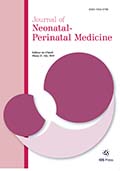Authors: Xu, E.H. | Claveau, M. | Yoon, E.W. | Barrington, K.J. | Mohammad, K. | Shah, P.S. | Wintermark, P. | Canadian Neonatal Network
Collaborators: Shah, Prakesh S | Kanungo, Jaideep | Ting, Joseph | Cieslak, Zenon | Sherlock, Rebecca | Yee, Wendy | Toye, Jennifer | Fajardo, Carlos | Kalapesi, Zarin | Sankaran, Koravangattu | Daspal, Sibasis | Seshia, Mary | Alvaro, Ruben | Mukerji, Amit | Da Silva, Orlando | Nwaesei, Chuks | Lee, Kyong-Soon | Dunn, Michael | Lemyre, Brigitte | Dow, Kimberly | Pelausa, Ermelinda | Barrington, Keith | Lapoint, Anie | Drolet, Christine | Piedboeuf, Bruno | Claveau, Martine | Beltempo, Marc | Bertelle, Valerie | Masse, Edith | Canning, Roderick | Makary, Hala | Ojah, Cecil | Monterrosa, Luis | Emberley, Julie | Afifi, Jehier | Kajetanowicz, Andrzej | Lee, Shoo K
Article Type:
Research Article
Abstract:
BACKGROUND: Birth asphyxia in term neonates remains a serious condition that causes significant mortality and long-term neurodevelopmental sequelae despite hypothermia treatment. The objective of this study was to review therapeutic hypothermia practices in a large population of neonates with hypoxic-ischemic encephalopathy (HIE) across Canada and to identify determinants of adverse outcome. METHODS: Our retrospective observational cohort study examined neonates≥36 weeks, admitted to the Canadian Neonatal Network NICUs between 2010 and 2014, diagnosed with HIE, and treated with hypothermia. Adverse outcome was defined as death and/or brain injury. Maternal, birth, and postnatal characteristics were compared between neonates with adverse
…outcome and those without. The association between the variables which were significantly different (p < 0.05) between the two groups and adverse outcome were further tested, while adjusting for gestational age, birth weight, gender, and initial severity of encephalopathy. RESULTS: A total of 2187 neonates were admitted for HIE; 52% were treated with hypothermia and 40% developed adverse outcome. Initial severity of encephalopathy (moderate, p = 0.006; severe, p < 0.0001), hypotension treated with inotropes (p = 0.001), and renal failure (p = 0.007) were significantly associated with an increased risk of death and/or brain injury. CONCLUSIONS: In asphyxiated neonates treated with hypothermia, not only their initial severity of encephalopathy on admission, but also their cardiac and renal complications during the first days after birth were significantly associated with risk of death and/or brain injury. Careful monitoring and cautious management of these complications is warranted.
Show more
Keywords: Birth asphyxia, hypoxic-ischemic encephalopathy, brain injury, magnetic resonance imaging
DOI: 10.3233/NPM-190368
Citation: Journal of Neonatal-Perinatal Medicine,
vol. 13, no. 4, pp. 449-458, 2020
Price: EUR 27.50





